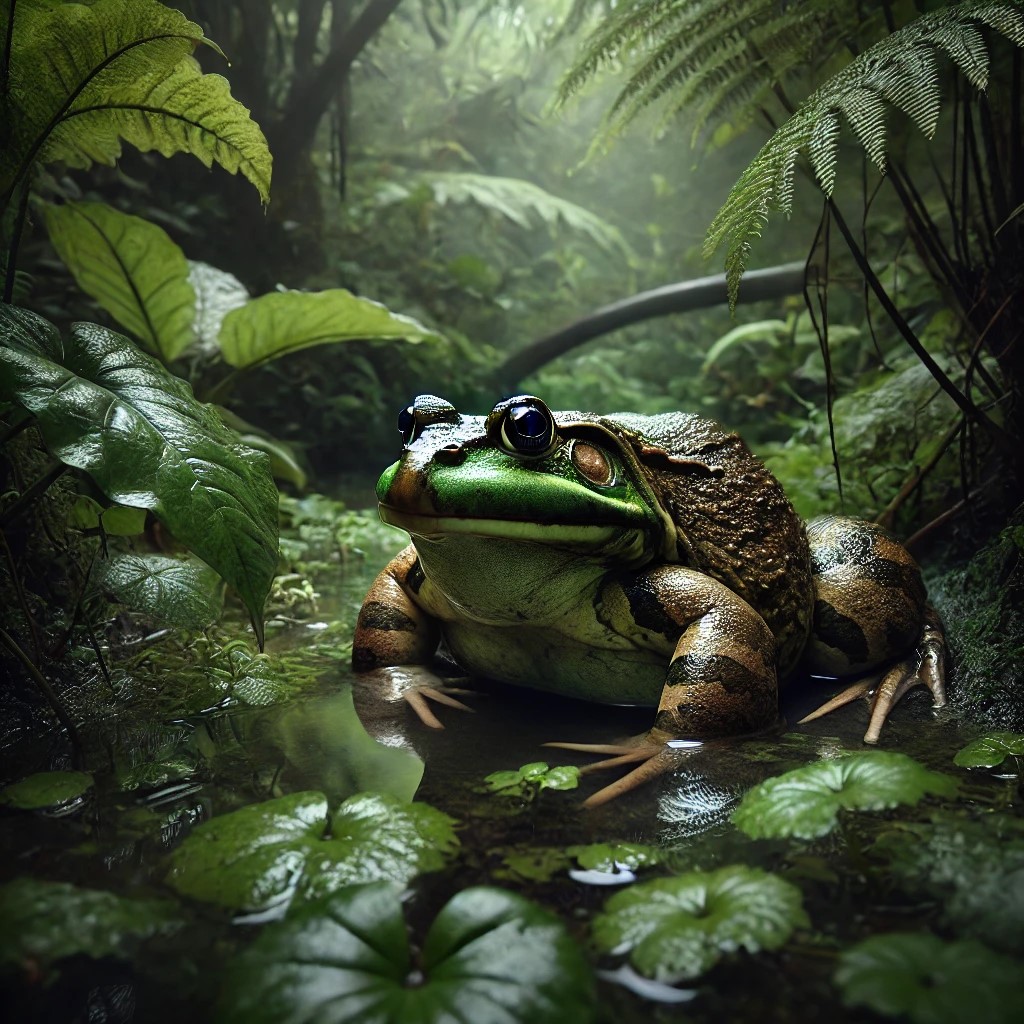Difference between revisions of "Frog (large poisonous)"
Tao alexis (talk | contribs) |
Tao alexis (talk | contribs) |
||
| Line 11: | Line 11: | ||
| HD = 2 | | HD = 2 | ||
| AP = 3 | | AP = 3 | ||
| + | | stride = 4 | ||
| THAC0 = 20 | | THAC0 = 20 | ||
| hpdie = d4 | | hpdie = d4 | ||
| − | | attack = head butt | + | | attack = '''1''': (head butt) |
| − | | dmg = 2–5 | + | | dmg = head butt (2–5) |
| − | | special = hop, | + | | special = [[Hop (attack)|hop]], [[Venom (substance)|venom]] |
}} | }} | ||
| − | + | '''Large poisonous frogs''' are recognised for the toxic secretion that coats their skin. Variants of these creatures display a range of colours, from the muted green-brown seen here to vivid shades of yellow, green and orange, with some exhibiting striations across their bodies. They thrive in dense, overgrown regions, hunting small creatures that navigate the underbrush. Though slightly smaller than their [[Frog (large)|large frog]] relatives, they possess tougher skin and greater agility. | |
| + | [[File:Frog, large poisonous.jpg|left|350px|thumb]] | ||
| + | __TOC__ | ||
| + | These frogs favour the littoral zone of ponds, remaining mostly submerged with only their eyes breaking the surface. This allows them to lie in wait for extended periods, watching for unsuspecting prey to pass within striking range. When attacking, they launch themselves with a sudden hop, using the momentum to drive their hardened, leathery heads into their target. | ||
| − | + | Those struck by the frog’s headbutt must make a [[Saving Throws|saving throw against poison]]. A successful save reduces the effect to a minor irritation, inflicting only 0–2 [[Damage (hit points)|damage]] in the following round; the head butt does an additional 2-5 damage. However, if the save is failed, the venom takes hold, dealing 4 damage per [[Combat Round|round]] for the next two rounds, resulting in a total of 8 damage. | |
| − | + | The hop costs 1 [[Action Points|action point]] and propels the frog forward a full 15 feet. Due to its ease of movement through dense underbrush, tracking the creature after it hops can be difficult. Following its initial attack, the frog will immediately retreat unless it is [[Stun Lock|stunned]]. The hop can be executed at any point during its movement, allowing for sudden, unpredictable shifts in position. If cornered, however, the frog abandons escape and will fight relentlessly to the death. | |
| − | |||
| − | |||
| − | |||
| − | |||
| − | |||
Revision as of 01:46, 10 February 2025
| Species | amphibian (beelzebufo erinyes) |
| No. Appearing | 2–12 |
| Behaviour | presocial |
| Range | rainforest, wetland |
| Size | 30 in. at head |
| Weight | 45–55 lbs. |
| Intelligence | 0 |
| Armour Class | 6 |
| Hit Dice | 2 |
| Action Points | 3 |
| Max. Stride | 4 |
| THAC0 | 20 |
| Hp/Die | d4 |
| Attack Forms | 1: (head butt) |
| Damage | head butt (2–5) |
| Special Attacks | hop, venom |
Large poisonous frogs are recognised for the toxic secretion that coats their skin. Variants of these creatures display a range of colours, from the muted green-brown seen here to vivid shades of yellow, green and orange, with some exhibiting striations across their bodies. They thrive in dense, overgrown regions, hunting small creatures that navigate the underbrush. Though slightly smaller than their large frog relatives, they possess tougher skin and greater agility.
These frogs favour the littoral zone of ponds, remaining mostly submerged with only their eyes breaking the surface. This allows them to lie in wait for extended periods, watching for unsuspecting prey to pass within striking range. When attacking, they launch themselves with a sudden hop, using the momentum to drive their hardened, leathery heads into their target.
Those struck by the frog’s headbutt must make a saving throw against poison. A successful save reduces the effect to a minor irritation, inflicting only 0–2 damage in the following round; the head butt does an additional 2-5 damage. However, if the save is failed, the venom takes hold, dealing 4 damage per round for the next two rounds, resulting in a total of 8 damage.
The hop costs 1 action point and propels the frog forward a full 15 feet. Due to its ease of movement through dense underbrush, tracking the creature after it hops can be difficult. Following its initial attack, the frog will immediately retreat unless it is stunned. The hop can be executed at any point during its movement, allowing for sudden, unpredictable shifts in position. If cornered, however, the frog abandons escape and will fight relentlessly to the death.
See also,
Amphibians & Reptiles (sage study)
Bestiary
